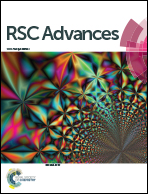Diastase assisted green synthesis of size-controllable gold nanoparticles†
Abstract
Diastase, a natural enzyme, was used for the one pot aqueous synthesis of gold nanoparticles (AuNPs) of tunable size. During the synthetic process, diastase acts concurrently as both a reducing and stabilizing agent, while no additional chemical reagents or surfactants are added. The formation of AuNPs was confirmed by using a UV-visible spectrophotometer, with a characteristic surface plasmon resonance (SPR) band at 530 nm. The size of the diastase-stabilized AuNPs can be easily controlled by changing the quantity of diastase. The produced AuNPs were characterized by using powder X-ray diffraction (XRD), UV-visible spectroscopy, Fourier transform infrared spectroscopy (FT-IR) and transmission electron microscopy (TEM). The FTIR spectrum revealed the capping of diastase on the surface of AuNPs. Furthermore, the formed gold nanoparticles are stable for more than three months. In vitro cytotoxicity studies by MTT assay on HCT116 and A549 cancer cells showed that the cytotoxicity of the as-synthesized Au nanocolloids depends on their size and dose.


 Please wait while we load your content...
Please wait while we load your content...